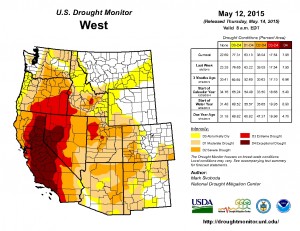The Wild West and the Spreading Drought
May 19th, 2015 | By admin | Category: Water IssuesBy Suzanne York, www.howmany.org.
It’s still a month until summer begins, and the drought in the western U.S. continues to be headline news. Just wait until August.
A couple of news items from the past week perfectly highlight the scope of the drought that is impacting the western U.S., and the role of human hubris in denying this reality.
The first news story of note comes from a state normally associated with days on end of gray days of drizzling rain. On May 15th, Gov. Jay Inslee of Washington State declared a statewide drought, due to low snow pack and rising temperatures. “The drought has deepened dramatically over the past few weeks,” Inslee stated. “It has spread quickly and now encompasses all of the state of Washington. We are already seeing severe impacts in several areas of the state, and conditions are expected to worsen over time.”
As reported by the Los Angeles Times, this is a snowpack drought, not a rain drought, and it’s expected to hit rural Washington the hardest and not affect major population centers – at least not yet. But the effects will still be harsh: the state Department of Agriculture predicts $1.2 billion in crop losses; wildlife officials are trying to figure out how to save the salmon; and firefighters are poised for disaster.
Down in California, the state is enduring its fourth year of a crippling drought, and residents are starting to feel the impact. And there is resistance to giving up the good life that so many of us have taken for granted for many decades now. Perhaps nothing reflects that resistance better than trying to keep lawns green.
Recently, the Bay Area News Group ran a news article on how the wealthy small town of Morada, in California’s Central Valley, is making use of a loophole in a nearly twenty-year old state proposition measure to prevent the use of water meters. Because of this, city residents are paying less than many homeowners in nearby cities while using eight times as much water as the county average.
A Morada resident is quoted in the article, and it shows how difficult change is in this town, not to mention this state, and this country. “These are estate-size lots, and it takes a lot of water to keep that much grass green,” said Morada resident Ed Schroeder, 72, a retired hospital executive. “If we switch to meters and everyone lets their lawn go, it will change this whole neighborhood.” Tell that to your grandchildren and future generations who may want to know why it was so important to water lawns instead of conserving this precious resource.
Peter Gleick, president of the respected Pacific Institute in Oakland, said, “the days when anyone could use as much water as they wanted without paying a fair price for the volume should be over.”
The same day that Washington declared a drought emergency it was reported that scientists are seeing clear signals that an El Niño weather pattern resulting in lots of rain could come to pass later this year. El Niños are notoriously hard to predict. They can last nine to 12 months, and in some cases go for as long as 18 months. But they can also fizzle out with disappointing speed.
You can bet though, that many people in Morada, CA and all over the drought-affected West are putting a lot of eggs in that El Niño basket. Otherwise, some of us might have to give up our “estate-size lots,” air-conditioned homes, swimming pools, lush, green lawns, and golf courses, as well as cheap, industrialized agriculture. And that wouldn’t be much fun, despite the high price that will be paid tomorrow.
Suzanne York is a senior writer with the Institute for Population Studies.


